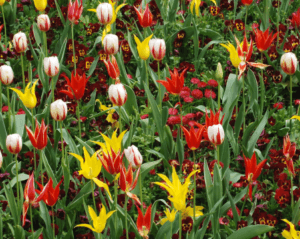Bamboos are such useful plants in planting design; these oversized grasses are well worth having a better look at!
Bamboos are part of the grass family, but they produce woody stems that include deposits of silica, which make the plant extremely tough. the main structural part of the bamboo plant is the rhizomes (underground root system), the aerial culms (stems) and the culm branches. The culms are not like those that are found on other woody plants due to the fact that the thickness of the emerging clum remains the same for the rest of its life and its maximum height can be achieved in its first growing season!
The growth and habit of a bamboo plant depends on the rhizomes; there are three differing types of rhizome systems.
Firstly is the clump forming species, which have short thick rhizomes, which produce a pretty tight group of culms above the ground. Then there is the ‘running’ species, which develop long thin rhizomes, which extend over great distances. These are the invasive species, and in many planting cases should be greatly avoided as they can become almost uncontrollable in many landscapes and can cause damage to hard landscaping. So many of these running rhizomes species should come with a cautionary warning! The third group are the intermediates, which have root systems that show characteristics of both the other groups.
When purchasing bamboos make sure that you check the root system (rhizomes) to make sure that there are plenty there, as this will indicate that the plant has been container grown rather than containerized. When buying bamboo plants the younger plants will establish better than buying large ones and will also cost a lot less (as is the case when buying most plants).
There is a species of bamboo suitable for most planting situations, especially as they tolerant of a wide range of soil conditions; providing they are not extremely wet or dry.
Bamboos are evergreen plants, their height and vertical structure mean that they can have a great range of uses in many planting schemes.
They are a fantastic plant selection when requiring height and structure in the landscape. Bamboo can provide an excellent winter presence at the back of border and are one of my favourite species to use as a screening effect in the garden.
They are a great choice in low maintenance and family gardens due to the low level of care they require and their robustness mean that they won’t be easily damaged. The qualities of bamboo also engage the senses, which can be a wonderful addition to any garden in the way that the stems rustle and swish in the wind. The strong vertical stems and delicate leaves of the plant make it a perfect candidate for uplighting at night. In a contemporary landscape, the plants can actually adopt an architectural role, especially when the branches are thinned.
Phyllostachys are probably the most us used bamboo species in garden and landscape planting. They are technically classified as runners, but in the cool temperate climate (such as the UK) they are well behaved, and do not aggressively spread as others would. They are also popular due to the brilliant array of colourful stems thats various species produce, such as the black stems of the P.nigra, the golden stems of the P.aurea and the yellow and green of P.aureosulcata. For smaller screening and bamboo hedging under 2 meters, the fargesia group are more useful. They have compact habit and when planted closely can provide a dense screening effect.
Bamboos have a wonderful range of uses in the design and planting of the garden and landscape but they are also vitally important as a major food source to many animals such as pandas and lemurs. Bamboos are of economic importance to humans as building material, food and medicine.
There are over 1,500 different species of bamboo growing naturally across every continent except Europe and Antarctica. Bamboo is among the fastest growing plants on earth with a Japanese species growing upwards at a rate of one meter per day, whilst other species never reach more than a couple of feet tall.


